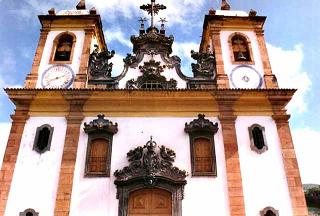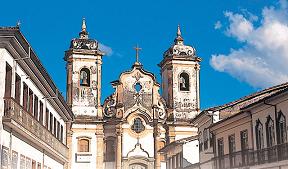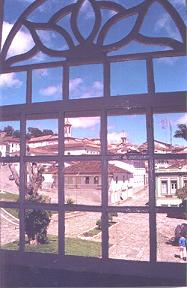Advertising by Google
Ouro Preto Churches
Below, a guide to the most famous churches in Ouro Preto, Brazil.
Notice that many churches close on Mondays. Some churches do not allow photos and filming.

Nossa Senhora do Carmo
Aleijadinho's last works are in this charming church, in the sacristy and on the altars of Nossa Senhora da Piedade (Our Lady of Mercy) and of the "Bound Christ". The church was built in 1766 and is the only church in the region decorated with Portuguese tiles from the 18th century. It also introduced the rococo style to Minas Gerais. The painting in the sacristy is by Mestre Athayde.
In the novice house beside the church is the grandiose Museu do Oratório, with 300 pieces of religious art from the 17th to 20th centuries and 160 splendid oratórios (small cabinets for individual praying containing images of saints) ranging from 3 cm (1 inch) to 3.2 meters (10.5 feet) in height. It also houses the so-called itinerant oratórios, which were carried on the back of mules for protectionduring muleteer's journeys, and the more refined oratórios which attested to the wealth of the church's congregation.
Igreja de São Francisco de Assis. This church, built in 1776, is Aleijadinho's masterpiece and the highest expression of the rococo style. It has some oddly military features, such as cylindrical towers that look like watchtowers, and roofs that resemble helmets adorned with spears.
The Cross of Lorena, with two arms flanked by balls of fire, is especially impressive. Inside, Aleijadinho created sculptures for the pulpits, wood panels, a soapstone sculpted door, the main chapel's altars, and the fountain of the sacristy. Mestre Athayde painted the ceiling, which appears higher thanks to the arrangement of the columns and parapets.

Nossa Senhora do Pilar
Igreja de Nossa Senhora do Pilar. This building was completed in 1731 as a replacement for the original main church, constructed between 1700 and 1707 of mud and wood reinforcements. It is considered the pinnacle of baroque opulence and dramatic quality.
Its austere façade is a sharp contrast to the lavish interior, decorated with 434 kg (956 lb) of gold and 400 kg (880 lb) of silver. Francisco Xavier de Brito, one of Aleijadinho's mentors, is believed to have designed the main altar.
Don´t miss the Museu de Arte Sacra in the basement of this church.
Matriz de Nossa Senhora da Conceição de Antonio Dias. This façade is very similar to the Pilar church, but the 1727 church distinguishes itself on the inside. The eight altars, four on each side, are lavishly decorated, and the church contains the graves of Aleijadinho and his father, Manuel Francisco Lisboa, who is believed to have adorned the nave.
The Museu Aleijadinho is located in the sacristy; this museum has priceless pieces such as a soapstone bust of São Francisco de Paula (Saint Francis of Paola), whose eyes appear lifelike.
Igreja de São José. The construction of this church, which replaced the original chapel dating from 1730, began around 1752 and was only completed in 1811. Aleijadinho, who served as Judge of Brotherhood, designed the chapel altar and the tower. Notice the soapstone banister around the central tower. The building is currently being renovated.

Nossa Senhora do Rosário
Igreja Nossa Senhora do Rosário. The unusual circular shape and three oval sections make this church somewhat similar to those of northern Europe. Constructed in 1785, it replaced the original chapel, built in 1709.
Igreja do Bom Jesus do Matosinhos. Built in the second half of the 18th century, this church has a magnificent soapstone portal, made by Aleijadinho. Mestre Athayde is believed to have painted the interior.
Igreja São Francisco de Paula. This is the newest church in Ouro Preto. Its construction started in 1804 and took more than 80 years to compepletion. Aleijadinho is credited with the sculpture of São Francisco de Paula. On the top floor, life-size sculptures represent the Last Supper. The church offers a breathtaking panoramic view of Ouro Preto.
Capela do Padre Faria. Built in the mid-18th century at the initiative of Father João Faria, this chapel, also known as Igreja Nossa Senhora do Rosário dos Brancos, is a small gem.
Well preserved, it's important historically (making the creation of the city) and architecturally, since it is the only remaining example of the first buildings in the Ouro Preto mountains. Notice the cross with three armsa in the church plaza, the scenes from the life of Mary on the side panels and the gilded wood carvings on the three tablets.
Read also: Hotels in Ouro Preto
Back to Top